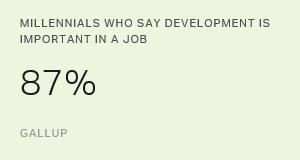For centuries, philosophers and social thinkers have postulated that the highest goal of human existence is to be happy. And many great thinkers have suggested that human happiness includes elements such as self-respect, material well-being, good health, meaningful work, and supportive families and communities.
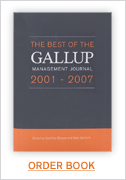 |
Until recently, research on happiness and well-being has mainly been the bailiwick of psychologists and social scientists. But thanks to the pioneering work of researchers such as Daniel Kahneman, Ph.D., a professor of psychology and public affairs at Princeton University and winner of the 2002 Nobel Prize in economics, economists are becoming increasingly interested in the question of happiness and how it affects business performance. (See "What Were They Thinking?" and "Are You Happy Now?" in the "See Also" area on this page.) Kahneman states, "Business is more about emotions than most businesspeople care to admit."
Other research on happiness in the workplace suggests that worker well-being plays a major role in organizational performance. In a survey conducted by the American Psychological Association in 2004, nearly two-thirds of all respondents indicated that their work lives had a significant impact on their stress levels, while one in four had called in sick or taken a "mental health day" as a result of stress at work. What's more, healthcare expenditures are nearly 50% greater for workers who report high stress levels, according to the Journal of Occupational and Environmental Medicine.
Organizations that understand the connections between worker stress and health and well-being can help their employees manage stress and find balance in their work and personal lives. When they do, productivity and engagement improve.
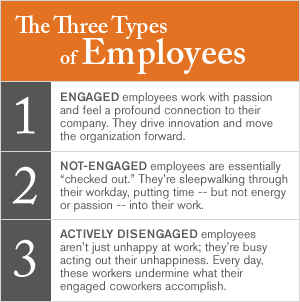 |
The role of supervisors
The Gallup Management Journal surveyed U.S. employees to probe their perceptions of how happiness and well-being affect their job performance. Gallup researchers examined employee responses to see which factors differed most strongly among engaged employees (27% of respondents) and those who were not engaged (59%) or actively disengaged (14%). (See sidebar "The Three Types of Employees" and graphic "The Cost of Disengagement.")
Previous Gallup research -- as well as results from this survey -- show that supervisors play a crucial role in worker well-being and engagement. When respondents were asked to respond to the statement "My supervisor focuses on my strengths or positive characteristics," 77% of engaged workers strongly agreed with the statement. Just 23% of not-engaged and a scant 4% of actively disengaged workers strongly agreed that their supervisor focused on their strengths or positive characteristics. Interestingly, not one engaged worker disagreed with this statement.
When survey respondents were asked how they would characterize their interactions with their coworkers, 86% of engaged employees said their interactions with coworkers were always positive or mostly positive. The findings for less engaged workers showed significantly different results: 72% of not-engaged workers characterized these interactions as always or mostly positive, compared to just 45% of actively disengaged workers.
These findings indicate that a positive relationship with the supervisor has an important effect on engagement. These findings also suggest that people with higher levels of job engagement enjoy substantially more positive interactions with their coworkers than do their less engaged counterparts.
 |
Feeling challenged?
When American employees were asked how often they feel challenged at work, a majority of engaged workers (61%) said they feel challenged very often, while 35% said they sometimes feel challenged. In contrast, just 49% of not-engaged and 24% of actively disengaged workers indicated that they very often feel challenged at work; 39% of not-engaged workers and 42% of actively disengaged workers sometimes feel challenged. It appears that while most American workers do perceive their jobs as being at least somewhat challenging, engaged employees lead the way in this respect.
But if most workers do feel challenged sometimes or very often at work, is that good or bad? To plumb this issue further, respondents were also asked how often they feel frustrated at work. Here, the differences were even more striking. Almost 4 in 10 engaged employees (39%) indicated that they rarely or never feel frustrated at work, while only 13% very often feel frustrated. In contrast, 6 in 10 actively disengaged workers and 26% of not-engaged employees said they very often feel frustrated. These responses suggest that while engaged workers do feel challenged at work, they view these challenges in a much more positive light than do less engaged workers.
The GMJ also wanted to find out if workers' feelings of self-worth had an effect on their engagement. They do. When asked how difficult it would be for their employer to replace them, 54% of disengaged employees said it would be extremely or somewhat difficult for their employer to replace them, compared to 76% of engaged employees. Engaged workers also felt significantly more secure at their workplaces: 54% of engaged workers felt more secure at work than they did a year ago, but only 36% of not-engaged workers and just 18% of actively disengaged workers agreed that they felt more secure at work than they did a year ago.
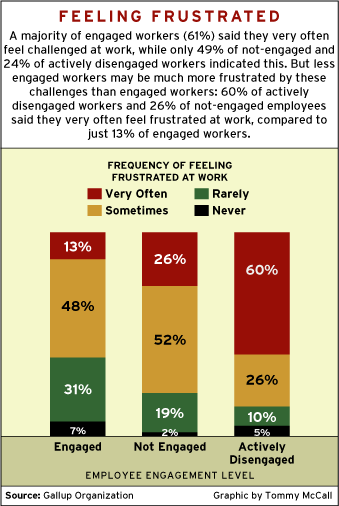 |
Taking stress home
To probe the connection between happiness at work and happiness outside the office, the survey asked respondents how much happiness they experience at work. The contrast in responses given by workers in each engagement group was quite noticeable. A clear majority of engaged workers -- 86% -- said they very often felt happy while at work. Among low-engagement respondents, only 11% of actively disengaged and 48% of not-engaged employees stated that they, too, were very often happy at work.
In response to the question "How much of the happiness you experience overall would you say comes from your work life?," 45% of engaged employees said they get a great deal of their overall happiness from their work life, compared to just 19% of not-engaged and 8% of actively disengaged employees. These findings suggest that while most workers experience varying degrees of happiness and well-being at work, engaged workers get the most from these feelings.
Not surprisingly, engaged workers also reported higher levels of overall life satisfaction. Five in 10 engaged workers (53%) strongly agreed that they had gotten the important things they want in their lives, compared to just 13% of actively disengaged workers; and 44% of engaged employees strongly agreed that the conditions of their lives were excellent, in contrast to just 9% of actively disengaged workers.
Negative feelings at work also seem to spill over into actively disengaged workers' home lives. The survey asked respondents if they had three or more days in the past month when work stress caused them to behave poorly with friends or family members. More than half (54%) of actively disengaged workers and 31% of not-engaged workers answered yes to this question, while just 17% of engaged workers answered yes. These results are similar to those reported in previous surveys. (See "Engagement Keeps the Doctor Away" and "Bringing Work Problems Home" in the "See Also" area on this page.)
The results of the GMJ Employee Engagement Index survey show a strong relationship between worker happiness and workplace engagement. Happy and engaged employees are much more likely to have a positive relationship with their boss, are better equipped to handle new challenges and changes, feel they are more valued by their employers, handle stress more effectively, and are much more satisfied with their lives.
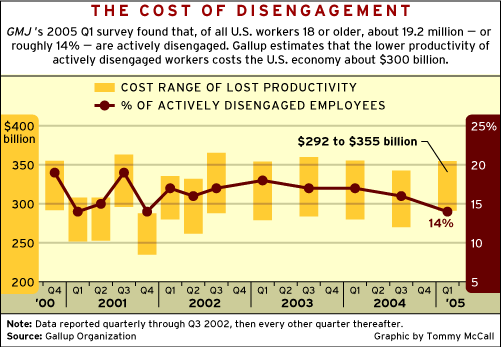 |
Results of this survey are based on nationally representative samples of about 1,000 employed adults aged 18 and older. Interviews were conducted by telephone October 2000-May 2005 by The Gallup Organization. For results based on samples of this size, one can say with 95% confidence that the error attributable to sampling and other random effects could be plus or minus three percentage points. For findings based on subgroups, the sampling error would be greater.
